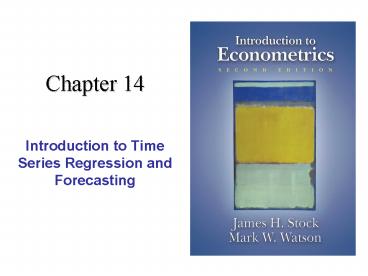Introduction to Time Series Regression and Forecasting PowerPoint PPT Presentation
1 / 100
Title: Introduction to Time Series Regression and Forecasting
1
Chapter 14
- Introduction to Time Series Regression and
Forecasting
2
Introduction to Time Series Regression and
Forecasting(SW Chapter 14)
3
Example 1 of time series data US rate of price
inflation, as measured by the quarterly
percentage change in the Consumer Price Index
(CPI), at an annual rate
4
Example 2 US rate of unemployment
5
Why use time series data?
6
Time series data raises new technical issues
7
Using Regression Models for Forecasting (SW
Section 14.1)
8
Introduction to Time Series Data and Serial
Correlation (SW Section 14.2)
9
We will transform time series variables using
lags, first differences, logarithms, growth
rates
10
Example Quarterly rate of inflation at an annual
rate (U.S.)
11
Example US CPI inflation its first lag and
its change
12
Autocorrelation
13
(No Transcript)
14
Sample autocorrelations
15
Example
16
(No Transcript)
17
Other economic time series
18
Other economic time series, ctd
19
Stationarity a key requirement for external
validity of time series regression
20
Autoregressions(SW Section 14.3)
21
The First Order Autoregressive (AR(1)) Model
22
Example AR(1) model of the change in inflation
23
Example AR(1) model of inflation STATA
24
Example AR(1) model of inflation STATA, ctd.
25
Example AR(1) model of inflation STATA, ctd
26
Forecasts terminology and notation
27
Forecast errors
28
Example forecasting inflation using an AR(1)
29
The AR(p) model using multiple lags for
forecasting
30
Example AR(4) model of inflation
31
Example AR(4) model of inflation STATA
32
Example AR(4) model of inflation STATA, ctd.
33
Digression we used ?Inf, not Inf, in the ARs.
Why?
34
So why use ?Inft, not Inft?
35
Time Series Regression with Additional Predictors
and the Autoregressive Distributed Lag (ADL)
Model (SW Section 14.4)
36
Example inflation and unemployment
37
The empirical U.S. Phillips Curve, 1962 2004
(annual)
38
The empirical (backwards-looking) Phillips Curve,
ctd.
39
Example dinf and unem STATA
40
Example ADL(4,4) model of inflation STATA,
ctd.
41
The test of the joint hypothesis that none of the
Xs is a useful predictor, above and beyond
lagged values of Y, is called a Granger causality
test
42
Forecast uncertainty and forecast intervals
43
The mean squared forecast error (MSFE) is,
44
The root mean squared forecast error (RMSFE)
45
Three ways to estimate the RMSFE
46
The method of pseudo out-of-sample forecasting
47
Using the RMSFE to construct forecast intervals
48
Example 1 the Bank of England Fan Chart,
11/05
49
Example 2 Monthly Bulletin of the European
Central Bank, Dec. 2005, Staff macroeconomic
projections
50
Example 3 Fed, Semiannual Report to Congress,
7/04
51
Lag Length Selection Using Information Criteria
(SW Section 14.5)
52
The Bayes Information Criterion (BIC)
53
Another information criterion Akaike Information
Criterion (AIC)
54
Example AR model of inflation, lags 06
55
Generalization of BIC to multivariate (ADL)
models
56
Nonstationarity I Trends(SW Section 14.6)
57
Outline of discussion of trends in time series
data
58
1. What is a trend?
59
(No Transcript)
60
(No Transcript)
61
What is a trend, ctd.
62
Deterministic and stochastic trends
63
Deterministic and stochastic trends, ctd.
64
Deterministic and stochastic trends, ctd.
65
Deterministic and stochastic trends, ctd.
66
Stochastic trends and unit autoregressive roots
67
Unit roots in an AR(2)
68
Unit roots in an AR(2), ctd.
69
Unit roots in the AR(p) model
70
Unit roots in the AR(p) model, ctd.
71
2. What problems are caused by trends?
72
Log Japan gdp (smooth line) and US inflation
(both rescaled), 1965-1981
73
Log Japan gdp (smooth line) and US inflation
(both rescaled), 1982-1999
74
3. How do you detect trends?
75
DF test in AR(1), ctd.
76
Table of DF critical values
77
The Dickey-Fuller test in an AR(p)
78
When should you include a time trend in the DF
test?
79
Example Does U.S. inflation have a unit root?
80
Example Does U.S. inflation have a unit root?
ctd
81
DF t-statstic 2.69 (intercept-only)
82
4. How to address and mitigate problems raised
by trends
83
Summary detecting and addressing stochastic
trends
84
Nonstationarity II Breaks and Model Stability
(SW Section 14.7)
85
A. Tests for a break (change) in regression
coefficients
86
(No Transcript)
87
Case II The break date is unknown
88
The Quandt Likelihod Ratio (QLR) Statistic (also
called the sup-Wald statistic)
89
The QLR test, ctd.
90
(No Transcript)
91
(No Transcript)
92
Has the postwar U.S. Phillips Curve been stable?
93
QLR tests of the stability of the U.S. Phillips
curve.
94
(No Transcript)
95
B. Assessing Model Stability using Pseudo
Out-of-Sample Forecasts
96
Application to the U.S. Phillips Curve
97
POOS forecasts of ?Inf using ADL(4,4) model with
Unemp
98
poos forecasts using the Phillips curve, ctd.
99
Summary Time Series Forecasting Models (SW
Section 14.8)
100
Summary, ctd.

